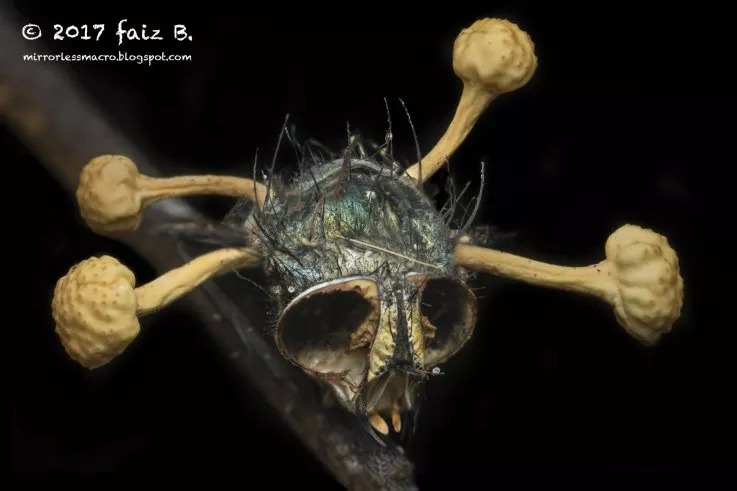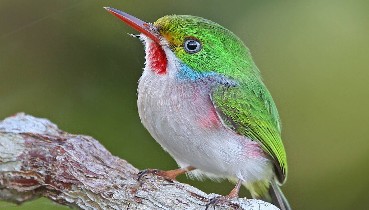

Disgusting Picture of Fly’s Head Infected with Parasitic Fungus will Fuel Your Nightmares
No, that isn’t a leaked image from the upcoming sequel to “The Last of Us.” That’s a real close-up of what was left of a fly’s head after it was infected with the Cordyceps fungus.
As a macro photographer in Singapore, Faiz Bustamente often has bugs in focus. Recently, he captured this picture of a fly with empty eye sockets, and a mysterious substance growing out of it. The photographer believes that a deadly fungus named Cordyceps had infected the fly, an assessment that online images of similar scenarios supports.
Cordyceps is as creepy as it looks—maybe even more so. Different species of Cordyceps prefer different hosts, but generally, they invade the bodies of insects, especially ants, causing them to act in a way some call zombie-like. The fungus forces its host to climb up to the top of a plant, clamp down onto it to steady itself, and wait to die. Then, the fungus slowly emerges through the bug’s exoskeleton, forming a stalk up through the top of the dead animal. The stalk rains spores down on insects below, starting the process all over again.

For a long time, experts believed that Cordyceps infected the brain of its host, compelling it to engage in these bizarre behaviors. However, new research published in the Proceedings of the National Academy of Sciences tells a different story. Using 3D Imaging and electron microscopy, a study found that Cordyceps invades the animal’s muscle fibers and leaves the brain intact. That means that the fungus controls what the insect is doing while the insect is fully aware but unable to stop it.
This fungus-addled fly is just one of the many fascinating corners of nature that Bustamente sees on his photography trips, during which he mostly documents insects and spiders. In an e-mail to Newsweek, Bustamente explained that he travels with a group of like-minded photographers around the forests of Singapore, where he finds the animals. He writes that sometimes he finds dead ones, and sometimes they are alive, and he has to rely on his experience with cameras and knowing his subjects to make sure he doesn’t scare them off before he gets the shot.
“Some bugs are tolerant of movements and would stay relatively still, while others like a jumping spider would run the moment you come close,” Bustamente wrote. “This would then influence they way you would approach a subject and how you would position the lens accordingly, in anticipation of its next move. It also helps to photograph them at night where they are generally more calm.”

To capture some of Earth’s smallest creatures, he decided to start using mirrorless macro cameras, which are portable and provide high-resolution images. He publishes his pictures and photography discussions at a blog called Mirrorless Macro.
Don’t worry, this parasitic fungus can’t infect humans. Despite it’s appearance as the zombie-making organism of the survival horror video game “The Last of Us,” it won’t take over your brain or muscles and then burst through your skin. In fact, some people intentionally ingest Cordyceps as a vitamin supplement, in the hopes of treating coughs, improving athletic performance, and other supposed benefits. You can even buy it in pill form, or buy little caterpillars with the fungus growing out of them. It’s completely unregulated.
Now if you’ll excuse me, I think I’ll climb to the top of a tall building and stay there for a little while.
Recommended Videos
 106 Of The Best Pics From The ‘Gardening1331 views
106 Of The Best Pics From The ‘Gardening1331 views 25 Examples Of The Absurd Levels Some People Go To With Image Editing Tools1354 views
25 Examples Of The Absurd Levels Some People Go To With Image Editing Tools1354 views-
Advertisements
 Drought Reveals “Spanish Stonehenge” Older Than the Pyramids.79 views
Drought Reveals “Spanish Stonehenge” Older Than the Pyramids.79 views Fly Geyser In Gerlach, Nevada3308 views
Fly Geyser In Gerlach, Nevada3308 views Showcases a bird with a unique and attractive combination of blue and yellow in its wings99 views
Showcases a bird with a unique and attractive combination of blue and yellow in its wings99 views The Giant Chinese Dobson Fly (Acanthacorydalis fruhstorferi)92 views
The Giant Chinese Dobson Fly (Acanthacorydalis fruhstorferi)92 views Meet Cuban Tody546 views
Meet Cuban Tody546 views The Met Gala red carpet's most revealing naked dresses worn by celebrities24291 views
The Met Gala red carpet's most revealing naked dresses worn by celebrities24291 views



